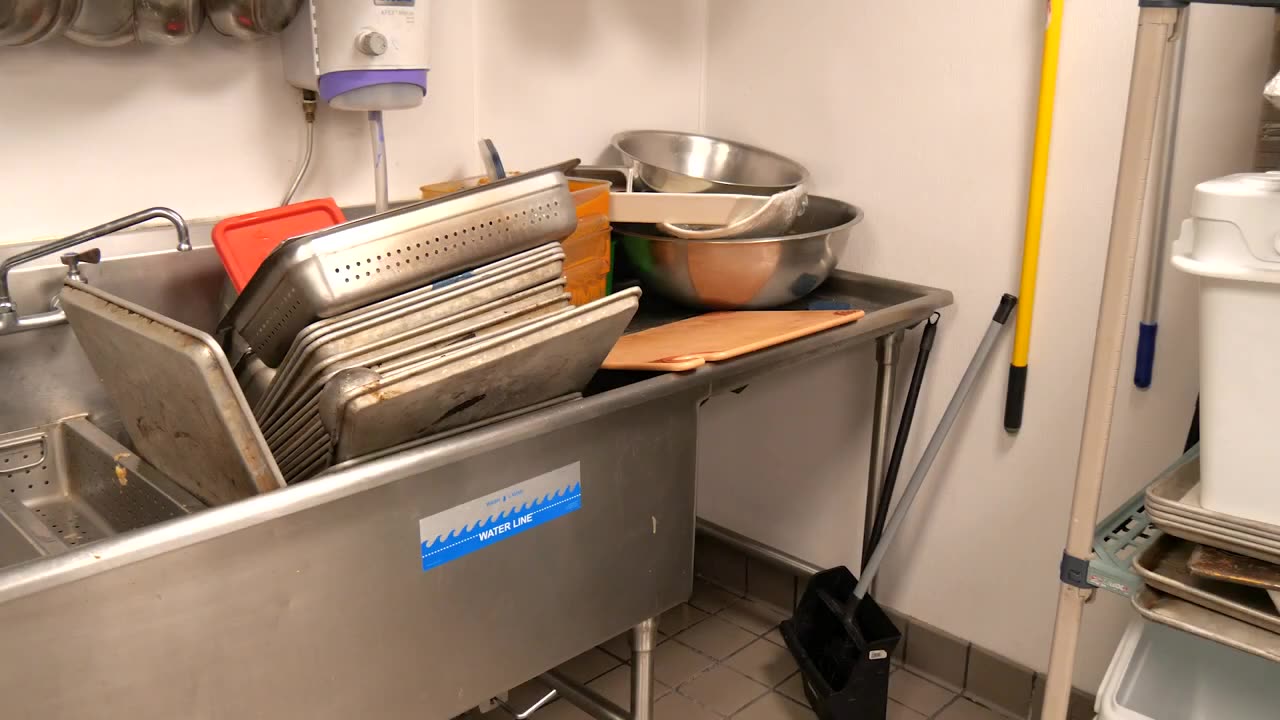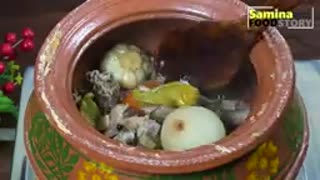Premium Only Content

Module 16 — Cleaning and Sanitizing Equipment
### **Module 16: Cleaning and Sanitizing Equipment**
Cleaning and sanitizing equipment are crucial steps in food safety to prevent the growth of harmful bacteria and reduce the risk of foodborne illnesses. This module covers the principles, methods, and best practices for effectively cleaning and sanitizing kitchen equipment.
---
### **1. The Importance of Cleaning and Sanitizing**
- **Prevents contamination**: Reduces the spread of pathogens that can contaminate food.
- **Promotes food safety**: Ensures that equipment is free from dirt, grease, food particles, and harmful microorganisms.
- **Maintains equipment**: Regular cleaning and sanitizing extend the life of kitchen equipment and tools.
- **Compliance with regulations**: Meeting food safety standards is required by health codes.
---
### **2. The Difference Between Cleaning and Sanitizing**
- **Cleaning**: The process of removing dirt, food particles, grease, and other visible contaminants from surfaces. Cleaning does not necessarily remove harmful microorganisms but makes surfaces ready for sanitizing.
- **Sanitizing**: The process of reducing harmful microorganisms to safe levels. Sanitizing usually follows cleaning and is done with chemical sanitizers or heat.
---
### **3. Steps in Cleaning and Sanitizing Equipment**
#### **A. Cleaning**
1. **Remove loose debris**: Scrape off any food particles, grease, or other residues from equipment and utensils.
2. **Wash**: Use warm water and a food-safe detergent to clean the surfaces of equipment. Scrub areas with grease or sticky residues with appropriate tools (e.g., brushes or scrapers).
3. **Rinse**: After washing, rinse equipment thoroughly with clean water to remove detergent and dirt.
#### **B. Sanitizing**
1. **Apply the sanitizer**: Use a chemical sanitizer or heat method to sanitize equipment after cleaning.
- **Chemical sanitizers**: Use sanitizers like chlorine bleach, quaternary ammonium compounds (quats), or iodine, following manufacturer instructions for concentration and contact time.
- **Heat sanitizing**: For equipment that can withstand high temperatures, you can sanitize by exposing it to hot water (at least 171°F or 77°C) or steam for the recommended duration.
2. **Allow proper contact time**: Ensure that the sanitizer remains in contact with the surface for the recommended amount of time to effectively reduce pathogens.
3. **Air dry**: Allow sanitized equipment to air dry. Avoid using towels to dry equipment, as they can reintroduce contaminants.
---
### **4. Types of Sanitizing Agents**
- **Chlorine**: Common in dishwashing solutions. Works effectively but must be used at the correct concentration (typically 50–100 ppm) and contact time (at least 7 seconds).
- **Quaternary Ammonium Compounds (Quats)**: Widely used for sanitizing food-contact surfaces. They are effective at lower concentrations (typically 200–400 ppm) and are often preferred for their low odor and effectiveness.
- **Iodine**: Effective against a wide range of pathogens. Typical concentration ranges from 12.5–25 ppm. It must be used with caution, as some foods can react with iodine.
- **Acidic Cleaners**: These are used for removing mineral deposits like limescale or rust but require careful handling.
---
### **5. Common Equipment and Cleaning Methods**
#### **A. Utensils (Knives, Spoons, Cutting Boards)**
- **Cleaning**: Wash utensils with warm soapy water and scrub to remove food particles.
- **Sanitizing**: Immerse them in a sanitizer solution or use a dishwasher with sanitizing capabilities.
#### **B. Cookware (Pots, Pans, Griddles)**
- **Cleaning**: Use a scrub brush or abrasive pad to remove food residue. For greasy items, use degreasing agents.
- **Sanitizing**: Follow the same steps as for utensils, ensuring contact with the sanitizer for the recommended time.
#### **C. Food-Contact Surfaces (Countertops, Tables)**
- **Cleaning**: Clean with warm soapy water to remove all food particles.
- **Sanitizing**: Wipe with a sanitizer solution. Ensure surfaces remain wet for the required time.
#### **D. Dishwashers**
- **Cleaning**: Clean the dishwasher itself by running a cleaning cycle with a dishwasher cleaner to remove grease, soap scum, and other residues.
- **Sanitizing**: Ensure the dishwasher reaches the correct temperature for sanitizing (e.g., at least 160°F or 71°C) or uses a chemical sanitizer during the final rinse cycle.
#### **E. Grills, Ovens, and Deep Fryers**
- **Cleaning**: Scrape and remove any food particles, grease, or charred residue. Use a degreaser where necessary.
- **Sanitizing**: After cleaning, sanitize surfaces that come into contact with food, especially after use for raw foods like meats.
---
### **6. Best Practices for Effective Cleaning and Sanitizing**
- **Use the right tools**: Ensure you have appropriate brushes, scrubbers, and cleaning cloths for different tasks.
- **Follow proper procedures**: Always clean and then sanitize. Never sanitize before cleaning, as debris and dirt can reduce the effectiveness of sanitizers.
- **Ensure proper concentration**: Always follow the manufacturer's instructions for sanitizers. Over- or under-concentrated solutions can be ineffective or harmful.
- **Change solutions regularly**: Replace cleaning and sanitizing solutions regularly to maintain their effectiveness, especially when they become dirty or diluted.
- **Clean as you go**: Clean up spills and food debris as soon as possible to prevent contamination and make deep cleaning tasks easier.
---
### **7. The Role of Cleaning and Sanitizing in Food Safety**
- **Prevents cross-contamination**: Proper cleaning and sanitizing reduce the spread of harmful microorganisms from one surface to another, especially between raw and ready-to-eat foods.
- **Reduces foodborne illnesses**: By removing harmful pathogens from equipment, you reduce the chances of contaminating food and causing illness.
- **Enhances hygiene**: Regularly cleaned and sanitized equipment improves the overall hygiene of the kitchen environment.
---
### **8. Common Mistakes to Avoid**
- **Using dirty cleaning tools**: Always clean brushes, sponges, and cloths to prevent them from becoming a source of contamination.
- **Not following the right contact time**: Rushing the sanitizing process can result in ineffective pathogen control.
- **Using non-food-safe cleaners**: Ensure that any cleaning agents used are labeled as safe for food-contact surfaces.
---
### **9. Training and Awareness**
- **Train staff regularly**: Ensure that kitchen staff understands the importance of cleaning and sanitizing and knows how to do it properly.
- **Document procedures**: Keep written procedures or checklists to ensure that all equipment is cleaned and sanitized properly.
- **Monitor compliance**: Supervisors should regularly inspect to ensure that cleaning and sanitizing protocols are followed.
---
### **Conclusion**
Cleaning and sanitizing equipment are essential steps in maintaining a safe and hygienic kitchen. By following proper procedures and using the correct tools and sanitizers, food handlers can prevent contamination, protect public health, and ensure food safety.
-
 7:58
7:58
HSESafetyInformation
9 months agoAuthentic Peshawari Rosh _ Namkeen Gosht Recipe __ Traditional KPK and Baluchistan
791 -
 31:10
31:10
The Why Files
3 days agoThe First Earth Battalion: America's Strangest Military Experiment
40.3K26 -
 4:18:02
4:18:02
SpartakusLIVE
5 hours ago#1 Pilgrim of PAIN Gives Thanks HAPPILY as he DESTROYS Enemies and BAGS LOOT
157K6 -
 59:47
59:47
iCkEdMeL
5 hours ago $26.81 earnedBREAKING: National Guard Soldier Dies + New Video Shows Suspect Opening Fire
18.1K29 -
 1:20:38
1:20:38
Flyover Conservatives
1 day agoThanksgiving’s Hidden History: Islamic Pirates, Spanish Threats, and Socialism - Bill Federer | FOC Show
26.6K3 -
 25:43
25:43
Russell Brand
1 day agoThis Is Getting Out Of Hand
119K113 -
 LIVE
LIVE
The Quartering
13 hours agoThanksgiving Day Yule Log!
1,757 watching -
 15:32
15:32
IsaacButterfield
21 hours ago $2.29 earnedAussie Reacts To UNHINGED Woke TikToks!
14.7K10 -
 3:24:28
3:24:28
PandaSub2000
13 hours agoNintendo Platformers - Thanksgiving 2025 Special | ULTRA BEST AT GAMES (Original Live Version)
35.4K8 -
 1:03:06
1:03:06
MetatronGaming
1 day agoThis is the scariest game ever (for an Italian)
24.9K9